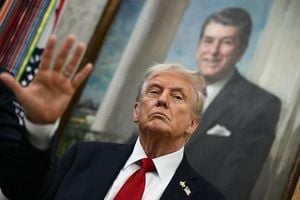The Office of the Director of National Intelligence (ODNI) is undergoing its most sweeping transformation since its creation, with Director Tulsi Gabbard announcing a plan to cut nearly half of the office’s workforce and slash more than $700 million from its annual budget. The move, unveiled on August 21, 2025, marks a dramatic shift for the agency tasked with synthesizing intelligence from 18 organizations across the federal government and comes amid fierce debate over the future of U.S. intelligence operations.
Gabbard, who has led the ODNI since early 2025, described the office as “bloated and inefficient,” blaming it for “abuse of power, unauthorized leaks of classified intelligence, and politicized weaponization of intelligence.” According to a news release cited by both TNND and the Associated Press, she argued that downsizing is necessary to restore public trust: “Ending the weaponization of intelligence and holding bad actors accountable are essential to begin to earn the American people’s trust which has long been eroded.”
Since taking the helm, Gabbard has already overseen the departure of around 500 staffers. The new cuts will see the ODNI’s headcount reduced by more than 40%, a change Gabbard says will save taxpayers over $700 million each year. However, the fact sheet released by her office only itemized $86 million in cuts, raising questions about where the rest of the savings will come from.
The reorganization targets several key ODNI units, including the Foreign Malign Influence Center, the National Counterproliferation and Biosecurity Center, the Cyber Threat Intelligence Integration Center, the External Research Council, and the Strategic Futures Group. Gabbard’s office claims that many of these groups have become redundant, with their core functions set to be merged into other agencies. Some, like the Foreign Malign Influence Center, are accused by Gabbard’s team of having been used by the previous administration to suppress free speech and censor political opposition.
The Foreign Malign Influence Center, established by the Biden administration in 2022, was intended to coordinate efforts to detect and counter foreign election interference—an issue that has become increasingly politically charged. The center played a visible role in debunking foreign disinformation, most notably its involvement in alerting the public to a Russian video that falsely depicted mail-in ballots being destroyed in Pennsylvania ahead of the 2024 presidential election, according to the Associated Press.
Gabbard, however, contends that the center’s focus had become too narrow, alleging it was “used by the previous administration to justify the suppression of free speech and to censor political opposition.” Her plan effectively terminates the center years ahead of its scheduled sunset in 2028, with its remaining work absorbed elsewhere.
The ODNI’s External Research Council and Strategic Futures Group face elimination as well. According to Gabbard’s office, the External Research Council was “filled with appointed partisans,” while the Strategic Futures Group, which was supposed to provide long-range threat forecasting, allegedly allowed the intelligence community’s “deep state” to “push a partisan political agenda.” Gabbard’s team even claimed that a draft of the 2025 global trends report “violated professional analytic tradecraft standards in an effort to propagate a political agenda that ran counter to all of the current President’s national security priorities.”
Reactions to these sweeping changes have split sharply along party lines. Republican Senator Tom Cotton, chair of the Senate Intelligence Committee, lauded the cuts as “an important step towards returning ODNI to that original size, scope, and mission. And it will help make it a stronger and more effective national security tool for President Trump.” Cotton expressed his eagerness to work with Gabbard on implementing the reforms, emphasizing the need for legislative support to help the intelligence community “focus on its core mission: stealing secrets from our adversaries.”
On the other side, Democratic Senator Mark Warner, the committee’s vice chair, voiced deep misgivings. He acknowledged that there was “broad agreement that the ODNI needs reform,” but questioned whether Gabbard was the right person for the job, especially after her recent decision to revoke the security clearances of dozens of career national security officials. “Given Director Gabbard’s track record of politicizing intelligence—including her decision just yesterday to revoke security clearances from career national security officials—I have no confidence that she is the right person to carry out this weighty responsibility,” Warner said in a statement. He pledged that Congress would exercise “rigorous oversight to ensure any reforms strengthen, not weaken, our national security.”
The Trump administration’s approach to intelligence reform extends beyond the ODNI. Earlier in 2025, the U.S. Cybersecurity and Infrastructure Security Agency saw significant cuts, and the State Department shuttered its office dedicated to countering foreign disinformation from Russia, China, and Iran. These moves reflect a broader cost-cutting mandate, championed by the Department of Government Efficiency, led by Elon Musk, which has presided over mass layoffs across the federal workforce.
Experts warn that the ODNI cuts, while potentially saving money, could have unintended consequences. Matthew Levinger, director of the National Security Studies Program at George Washington University, told TNND that national security depends on “clear and independent analysis of critical short-term and long-term threats,” and that ODNI staff play a vital role in providing such analysis. “It is very important that all government agencies be highly efficient, and yet from the announcement by DNI Gabbard, it’s not clear that efficiency is the No. 1 objective of this proposal,” Levinger said. He warned that the cuts “seem to be occurring with an axe rather than a scalpel,” and cautioned that “by defunding parts of the intelligence community that are producing analysis that may be unwelcome to senior policymakers, U.S. leaders are blinding themselves to potential future challenges that require an agile and robust response.”
Emerson Brooking, a resident fellow at the Atlantic Council’s Digital Forensic Research Lab, also pushed back on the notion that the Foreign Malign Influence Center was redundant. “It wasn’t redundant, it was supposed to solve for redundancy,” Brooking told the Associated Press, emphasizing the center’s unique role in parsing intelligence assessments and ensuring decision-makers got the full picture.
The controversy over ODNI’s future comes at a time of heightened scrutiny of the intelligence community’s role in shaping public discourse and policy. The office’s involvement in election-related work, especially after the 2016 and 2020 presidential elections, has made it a lightning rod for criticism from both sides of the aisle. Gabbard’s fact sheet even accused ODNI of becoming “hyper-focused” on election issues after a “manufactured” intelligence assessment allegedly mischaracterized Russian President Vladimir Putin’s intentions in 2016.
As the dust settles, the debate over the right balance between efficiency, independence, and accountability in the intelligence community is far from over. Lawmakers and experts alike will be watching closely to see whether Gabbard’s bold gamble pays off—or if it leaves the United States less prepared for the threats of tomorrow.




